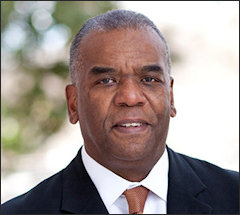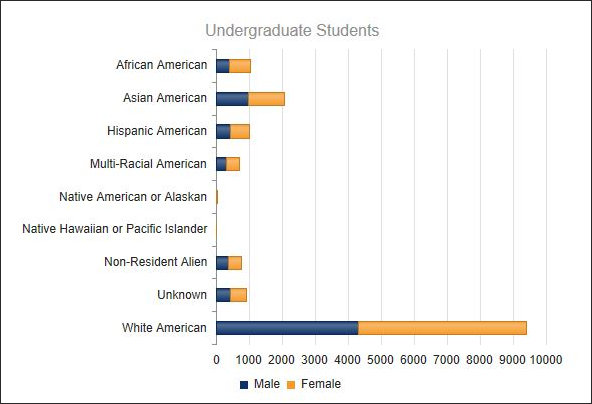
Marcus Martin, chief diversity officer at UVa
The University of Virginia is paying its Chief Officer for Diversity and Equity, Marcus Martin, $349,000 a year — the highest salary of any of 50 higher-education diversity officer identified by Campus Reform, a project of the conservative, non-profit Leadership Institute.
How much money are public universities devoting to their diversity bureaucracies, Campus Reform asks, and could that money provide a greater benefit to minority students in the form of financial aid?
While Michael Poliakoff, president of the American Council of Trustees and Alumni (ACTA), acknowledged to Campus Reform that “colleges today are educating a much broader range of students,” he suggested that “it is certainly worth asking whether runaway expenditures on inclusion and diversity staff are actually helping to create a campus where students of different backgrounds share their experiences and views.”
“Too many institutions spend lavishly on teams of highly-compensated and narrowly-focused administrative specialists,” he added, noting that the University of California at Berkeley “spends $18 million annually on a staff of 150 in its Office of Inclusion and Equity.”
“Let’s turn these funds instead to bringing more deserving students from underserved backgrounds to Berkeley,” Poliakoff continued. “It is crucial for boards and leaders to ask whether spending on new administrative salaries will serve the genuine needs of students or just fulfill the wishes of certain administrators.”
So, how big is UVa’s diversity bureaucracy? It’s difficult to say from a perusal of the website. Unlike academic departments, which typically list all professors, instructors and staff on the Web, the Office of Diversity and Equity does not. But we can glean some details.
UVa’s Office of Diversity and Equity (ODE) describes its mission this way:
[The Office] assists and monitors all units of the University in their efforts to recruit and retain faculty, staff, and students from historically underrepresented groups and to provide affirmative and supportive environments for work and life at the University of Virginia.
[It] provides leadership, information, consultation, coordination, and assistance to the various units and constituencies within the University of Virginia in an effort to embrace diversity and equity as pillars of excellence, synergize actions at all levels of the institution, and cultivate inclusiveness and mutual respect throughout the community.
While the ODE does not list its employees, it does link to various committees including the Diversity Council, which pulls in 38 committee members from around the university; the Disability Advocacy and Action Committee, which lists a chairperson and staff member; the LGBT Committee, which also has a chair person and staff member; the Women’s Leadership Council, which consists of 15 committee members; and the President’s Commission on Slavery and the University.
Individual schools at UVa also maintain their own mini-diversity bureaucracies. For example, the McIntire School of Commerce has an Office of Diversity, Equity & Inclusion. The Engineering school has a Center for Diversity in Engineering. The law school and Darden school of business also cite extensive activities and partnerships relating to diversity.
Last but not least, the University also has something called the Idea Fund, which enjoys a “close relationship” with the Office for Diversity and Equity, and is staffed by that office. The Idea Fund lists the following:
- Marcus Martin, M.D. – Vice President and Chief Officer for Diversity and Equity
- Meghan Saunders Faulkner – Assistant to the Vice President and Chief Officer for Diversity and Equity for Programs and Projects
- Jessica McCauley – Virginia-North Carolina Alliance Program Coordinator
- Kristin L. Morgan – Director, University & Community Relations and Development
- Gail Prince-Davis – Administrative Assistant to the Vice President
- Debra White – Director of Business Operations and Grants Management
Here’s what the Idea Fund does:
IDEA Fund Trustees generally advocate for the promotion of the Fund’s values within the University. Through meetings and communications with alumni, administrators, staff, students, community members and faculty, IDEA Fund Trustees are committed to staying abreast of, collaborating on, and sponsoring events, programs, committees, symposia and appointments that serve its values. Examples of this are collaborations on past annual MLK celebration events, sponsorships of symposia, statements of support and concern to University leadership on topics that are relevant to the Fund’s mission, and providing mentoring support to minority/underrepresented students, faculty, and staff at the University through focused alumni networking and contacts.
Whatever else these people do, it’s evident that they hold a lot of meetings and participate in a lot of events, programs and symposia. Whether all this activity adds up to substantive support for minority students or mainly constitutes a lot of ivory tower navel-gazing is less clear.
So, how effective is the Office of Diversity and Equity? Take a look at the Office’s Diversity Dashboard, and you’ll find that UVa, despite its commitment to ethnic diversity, isn’t very diverse. Here’s the breakdown of undergraduate students:

That’s the flattering graph. The stats for faculty, graduate students, and staff show even less diversity — although the university is making an effort to change that. Thirty-one percent of the Tenure Track & Tenured professors hired in 2015-16 were non-white.
The underlying assumption of all this bureaucratic activity is that ethnic minorities need more than financial aid to attend UVa. They need the ministrations of a small army of diversity administrators. That’s a convenient assumption for university administrators to have. Perhaps someone should ask minority students which they would prefer: more diversity administrators or more financial aid?
Hat tip: Elena Siddall


